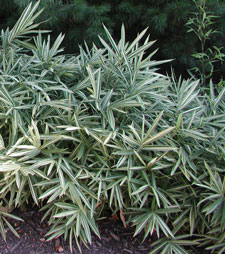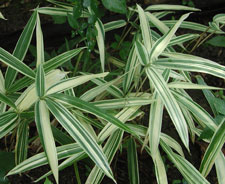Resource Library
Plant of the Week: Whitestripe, Dwarf Bamboo
The University of Arkansas System Division of Agriculture does not promote, support or recommend plants featured in "Plant of the Week." Please consult your local Extension office for plants suitable for your region.
Plant of the Week
Dwarf Whitestripe Bamboo
Latin: Pleioblastus fortunei

About 10 years ago, I acquired an assortment of dwarfish bamboos for planting in my Japanese garden. Being fully aware of their reputation for invasiveness, I went ahead and planted them with reckless abandon. Of the five kinds I planted, one of my favorites is the dwarf whitestripe bamboo, Pleioblastus fortunei.
For me, the dwarf whitestripe bamboo grows about a foot tall but in good soil it's said to get twice as high. Its stems (culms) are about the size of a small soda straw with a terminal cluster of 4 to 7 leaves held at right angles to the stem. The leaves are 4 inches to 5 inches long and about ¾-inch wide with an acutely pointed tip.
Each leaf has a different variegation pattern. On some leaves, half of the leaf will be white and half green. On others, there will be alternating bands of white and green. Occasionally an almost all white or all green leaf will be found. In mild areas the plant is evergreen but below 20 degrees the leaves will be killed.
Pleioblastus is a running bamboo. In good soils, the rhizome will be to a foot deep, but in heavy clay it's shallow, often creeping along just beneath the soil surface. The Latin name translates as "many buds," a reference to the numerous buds arising along the length of the rhizome. Each bud can produce a new culm.
This plant was most likely collected about 1861 by Robert Fortune from a Japanese garden he was visiting. Fortune, the plant explorer sponsored by the Royal Horticulture Society of England, is best known for his collections of Chinese plants just after the first Opium War in 1841. But he also visited Japan after Commodore Perry and his fleet of U.S. Navy ships forced Japan to open its ports for Western trade in 1854.
Louis van Houtte (1810-1876), a nurseryman from Belgium best remembered today for the Van Houtte spirea which is still common in gardens, listed whitestripe bamboo in his 1863 catalog as "Bambusa fortunei," only one of the dozen Latin names the plant has carried since being first offered. It wasn't until 1979 when a clump of this species flowered in Brazil were botanists able to observe flowers and finally settle on an agreed-upon Latin name.

For me this bamboo has not been aggressive or troublesome. Its rhizomes creep about, expanding the size of the colony about 6 inches a year. Occasionally a rhizome will reach out a couple feet from the colony. These errant shoots are simply pulled up and the size of the patch controlled. Like any running bamboo, if it's ignored year after year, it will eventually creep into unwanted areas. The better the soil, the sooner the escape will happen.
If fear of spread is a serious concern, plant this groundcover in an area where it can't escape. Ideal locations would be narrow beds confined by concrete walkways on one side and a building on the other or even confined in parking lot islands.
More modest patches can be controlled by cutting the bottom out of a large plastic nursery container or an old plastic trash can and then burying this in the border. Leave the rim of the container up an inch or two to keep stems from jumping the fence. As long as the container is deep enough to extend into the clay subsoil of the site, rhizomes should not escape from the bottom of the container.
Dwarf whitestripe bamboo is winter hardy to zone 6 and will grow in full sun to moderate shade. In full sun the white portions of the leaf may scorch so plants look best with some afternoon shade. Like most bamboos this plant responds positively to good soil, high fertility and water. So, to keep it in bounds and prevent overly aggressive spread, plant it in unamended soils and don't encourage rapid spread by excessive fertilization or watering. If used as a groundcover, mow the planting in the spring just before new growth begins to keep size down and encourage uniformity.
By: Gerald Klingaman, retired
Extension Horticulturist - Ornamentals
Extension News - June 29, 2007
The University of Arkansas System Division of Agriculture does not maintain lists of retail outlets where these plants can be purchased. Please check your local nursery or other retail outlets to ask about the availability of these plants for your growing area.